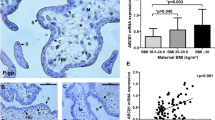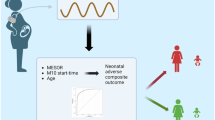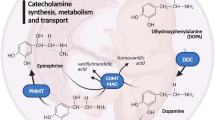Abstract
Objectives
We investigated the relationship between maternal pre-pregnancy body mass index (BMI) and expression of key serotonin-regulating genes (namely, metabolic enzymes, transmembrane transporters and receptors) in term placentas, including a possible moderating effect of glucose tolerance status (normal glucose tolerance (NGT) vs. gestational diabetes mellitus (GDM)). Associations between placental expression of serotonin-regulating genes and neonatal anthropometry were also explored.
Methods
The study included 105 women with overweight/obesity (OWO) and 111 women with normal–weight (NW), all giving birth at term by planned cesarean section. Placental tissue was collected from the fetal side using a standardized protocol. Expression of serotonin-regulating genes was quantified by RT–qPCR and/or ELISA.
Results
Pre-pregnancy OWO, GDM or their interaction were not associated with mRNA levels of tryptophan hydroxylase 1 (TPH1), monoamine-oxidase A (MAOA), organic cation transporter 3 (OCT3), and serotonin receptor 2A (HTR2A) in term placentas. However, mRNA levels of plasma membrane monoamine transporter (PMAT) were significantly upregulated in association with pre-pregnancy OWO, regardless of GDM status (p = 0.014). Furthermore, in women with NGT, but not in women with GDM, pre-pregnancy OWO was associated with decreased placental serotonin transporter (SERT) mRNA levels (p = 0.001), while placental SERT protein levels were increased in women with pre-pregnancy OWO and further elevated in women with concurrent GDM (p = 0.005). In addition, higher placental SERT mRNA levels negatively predicted birth weight and newborn length and, in women with NGT, partially mediated the association between pre-pregnancy BMI and birth weight.
Conclusion
The results show associations between maternal pre-pregnancy OWO and altered expression of high- and low-affinity serotonin transport genes (SERT and PMAT, respectively). Among the genes analyzed, SERT may play a role in linking maternal OWO to fetal growth. The results underscore the importance of further functional studies into the placental serotonin system in the context of maternal OWO.
This is a preview of subscription content, access via your institution
Access options
Subscribe to this journal
Receive 12 print issues and online access
$259.00 per year
only $21.58 per issue
Buy this article
- Purchase on SpringerLink
- Instant access to full article PDF
Prices may be subject to local taxes which are calculated during checkout


Similar content being viewed by others
Data availability
The PlaNS datasets analyzed in the current study are not publicly available because consent for public release of data was not obtained from participants. However, data to generate figures and tables are available from the corresponding author on reasonable request and with appropriate permission from the PlaNS study team and investigators.
References
Chen C, Xu X, Yan Y. Estimated global overweight and obesity burden in pregnant women based on panel data model. PLoS One. 2018;13:e0202183 https://doi.org/10.1371/journal.pone.0202183.
Stival C, Lugo A, Odone A, van den Brandt PA, Fernandez E, Tigova O, et al. Prevalence and correlates of overweight and obesity in 12 european countries in 2017-2018. Obes Facts. 2022;15:655–65. https://doi.org/10.1159/000525792.
Vince K, Brkić M, Poljičanin T, Matijević R. Prevalence and impact of pre-pregnancy body mass index on pregnancy outcome: a cross-sectional study in Croatia. J Obstet Gynaecol. 2021;41:55–9. https://doi.org/10.1080/01443615.2019.1706157.
Marchi J, Berg M, Dencker A, Olander EK, Begley C. Risks associated with obesity in pregnancy, for the mother and baby: a systematic review of reviews. Obes Rev. 2015;16:621–38. https://doi.org/10.1111/obr.12288.
Shirvanifar M, Ahlqvist VH, Lundberg M, Kosidou K, Herraiz-Adillo Á, Berglind D, et al. Adverse pregnancy outcomes attributable to overweight and obesity across maternal birth regions: a Swedish population-based cohort study. Lancet Public Health. 2024;9:e776–86. https://doi.org/10.1016/S2468-2667(24)00188-9.
Godfrey KM, Reynolds RM, Prescott SL, Nyirenda M, Jaddoe VWV, Eriksson JG, et al. Influence of maternal obesity on the long-term health of offspring. Lancet Diab Endocrinol. 2017;5:53–64. https://doi.org/10.1016/S2213-8587(16)30107-3.
Kong L, Chen X, Gissler M, Lavebratt C. Relationship of prenatal maternal obesity and diabetes to offspring neurodevelopmental and psychiatric disorders: a narrative review. Int J Obes. 2020;44:1981–2000. https://doi.org/10.1038/s41366-020-0609-4.
Mahase E. Obesity: no European country is on track to halt rising levels by 2025, WHO warns. BMJ. 2022;377:o1107. https://doi.org/10.1136/bmj.o1107.
Burton GJ, Fowden AL. The placenta: a multifaceted, transient organ. Philos Trans R Soc Lond B Biol Sci. 2015;370:20140066. https://doi.org/10.1098/rstb.2014.0066.
Segura MT, Demmelmair H, Krauss-Etschmann S, Nathan P, Dehmel S, Padilla MC, et al. Maternal BMI and gestational diabetes alter placental lipid transporters and fatty acid composition. Placenta. 2017;57:144–51. https://doi.org/10.1016/j.placenta.2017.07.001.
Musa E, Salazar-Petres E, Arowolo A, Levitt N, Matjila M, Sferruzzi-Perri AN. Obesity and gestational diabetes independently and collectively induce specific effects on placental structure, inflammation and endocrine function in a cohort of South African women. J Physiol. 2023;601:1287–306. https://doi.org/10.1113/JP284139.
Beneventi F, Bellingeri C, De Maggio I, Cavagnoli C, Fumanelli S, Ligari E, et al. Placental pathologic features in obesity. Placenta. 2023;144:1–7. https://doi.org/10.1016/j.placenta.2023.10.011.
Louwen F, Kreis N-N, Ritter A, Yuan J. Maternal obesity and placental function: impaired maternal-fetal axis. Arch Gynecol Obstet. 2024;309:2279–88. https://doi.org/10.1007/s00404-024-07462-w.
Zhang CXW, Candia AA, Sferruzzi-Perri AN. Placental inflammation, oxidative stress, and fetal outcomes in maternal obesity. Trends Endocrinol Metab. 2024;35:638–47. https://doi.org/10.1016/j.tem.2024.02.002.
Hadden C, Fahmi T, Cooper A, Savenka AV, Lupashin VV, Roberts DJ, et al. Serotonin transporter protects the placental cells against apoptosis in caspase 3-independent pathway. J Cell Physiol. 2017;232:3520–9. https://doi.org/10.1002/jcp.25812.
Reviriego J, Fernandez-Alfonso MS, Marín J. Actions of vasoactive drugs on human placental vascular smooth muscle. Gen Pharm. 1990;21:719–27. https://doi.org/10.1016/0306-3623(90)91024-l.
Thibeault A-AH, de Los Santos YL, Doucet N, Sanderson JT, Vaillancourt C. Serotonin and serotonin reuptake inhibitors alter placental aromatase. J Steroid Biochem Mol Biol. 2019;195:105470. https://doi.org/10.1016/j.jsbmb.2019.105470.
Mao J, Kinkade JA, Bivens NJ, Roberts RM, Rosenfeld CS. Placental changes in the serotonin transporter (Slc6a4) knockout mouse suggest a role for serotonin in controlling nutrient acquisition. Placenta. 2021;115:158–68. https://doi.org/10.1016/j.placenta.2021.09.021.
Côté F, Fligny C, Bayard E, Launay J-M, Gershon MD, Mallet J, et al. Maternal serotonin is crucial for murine embryonic development. Proc Natl Acad Sci USA. 2007;104:329–34. https://doi.org/10.1073/pnas.0606722104.
Bonnin A, Goeden N, Chen K, Wilson ML, King J, Shih JC, et al. A transient placental source of serotonin for the fetal forebrain. Nature. 2011;472:347–50. https://doi.org/10.1038/nature09972.
Goeden N, Velasquez J, Arnold KA, Chan Y, Lund BT, Anderson GM, et al. Maternal inflammation disrupts fetal neurodevelopment via increased placental output of serotonin to the fetal brain. J Neurosci. 2016;36:6041–9. https://doi.org/10.1523/JNEUROSCI.2534-15.2016.
Perić M, Bečeheli I, Čičin-Šain L, Desoye G, Štefulj J. Serotonin system in the human placenta—the knowns and unknowns. Front Endocrinol. 2022;13:1061317. https://doi.org/10.3389/fendo.2022.1061317.
Laurent L, Deroy K, St-Pierre J, Côté F, Sanderson JT, Vaillancourt C. Human placenta expresses both peripheral and neuronal isoform of tryptophan hydroxylase. Biochimie. 2017;140:159–65. https://doi.org/10.1016/j.biochi.2017.07.008.
Kliman HJ, Quaratella SB, Setaro AC, Siegman EC, Subha ZT, Tal R, et al. Pathway of maternal serotonin to the human embryo and fetus. Endocrinology. 2018;159:1609–29. https://doi.org/10.1210/en.2017-03025.
Balkovetz DF, Tiruppathi C, Leibach FH, Mahesh VB, Ganapathy V. Evidence for an imipramine-sensitive serotonin transporter in human placental brush-border membranes. J Biol Chem. 1989;264:2195–8. https://doi.org/10.1016/S0021-9258(18)94161-X.
Chan JC, Alenina N, Cunningham AM, Ramakrishnan A, Shen L, Bader M, et al. Serotonin transporter-dependent histone serotonylation in placenta contributes to the neurodevelopmental transcriptome. J Mol Biol. 2024:168454. https://doi.org/10.1016/j.jmb.2024.168454.
Levy M, Kovo M, Miremberg H, Anchel N, Herman HG, Bar J, et al. Maternal use of selective serotonin reuptake inhibitors (SSRI) during pregnancy-neonatal outcomes in correlation with placental histopathology. J Perinatol. 2020;40:1017–24. https://doi.org/10.1038/s41372-020-0598-0.
De Ponti F. Pharmacology of serotonin: what a clinician should know. Gut. 2004;53:1520–35. https://doi.org/10.1136/gut.2003.035568.
McIntyre HD, Catalano P, Zhang C, Desoye G, Mathiesen ER, Damm P. Gestational diabetes mellitus. Nat Rev Dis Prim. 2019;5:1–19. https://doi.org/10.1038/s41572-019-0098-8.
Horvatiček M, Perić M, Bečeheli I, Klasić M, Žutić M, Kesić M, et al. Maternal metabolic state and fetal sex and genotype modulate methylation of the serotonin receptor type 2A gene (HTR2A) in the human placenta. Biomedicines. 2022;10:467. https://doi.org/10.3390/biomedicines10020467.
Bečeheli I, Horvatiček M, Perić M, Nikolić B, Holuka C, Klasić M, et al. Methylation of serotonin regulating genes in cord blood cells: association with maternal metabolic parameters and correlation with methylation in peripheral blood cells during childhood and adolescence. Clin Epigenetics. 2024;16:4. https://doi.org/10.1186/s13148-023-01610-w.
Ye J, Zhang L, Chen Y, Fang F, Luo Z, Zhang J. Searching for the definition of macrosomia through an outcome-based approach. PLoS One. 2014;9:e100192. https://doi.org/10.1371/journal.pone.0100192.
Metzger BE, Gabbe SG, Persson B, Lowe LP, Dyer AR, Oats JJN, et al. International association of diabetes and pregnancy study groups recommendations on the diagnosis and classification of hyperglycemia in pregnancy: response to weinert. Diab Care. 2010;33:e98. https://doi.org/10.2337/dc10-0719.
Lovrenčić MV, Honović L, Kralik S, Matica J, Prašek M, Pape-Medvidović E, et al. Redefinition of gestational diabetes mellitus: implications for laboratory practice in Croatia. Biochem Med. 2013;23:7–11. https://doi.org/10.11613/BM.2013.002.
Goldberg JD, El-sayed YY. Committee Opinion No 700: methods for estimating the due date. Obstet Gynecol. 2017;129:e150–4. https://doi.org/10.1097/AOG.0000000000002046.
Blazevic S, Horvaticek M, Kesic M, Zill P, Hranilovic D, Ivanisevic M, et al. Epigenetic adaptation of the placental serotonin transporter gene (SLC6A4) to gestational diabetes mellitus. PLoS One. 2017;12:e0179934. https://doi.org/10.1371/journal.pone.0179934.
Bustin SA, Benes V, Garson JA, Hellemans J, Huggett J, Kubista M, et al. The MIQE guidelines: minimum information for publication of quantitative real-time PCR experiments. Clin Chem. 2009;55:611–22. https://doi.org/10.1373/clinchem.2008.112797.
Xie F, Wang J, Zhang B. RefFinder: a web-based tool for comprehensively analyzing and identifying reference genes. Funct Integr Genom. 2023;23:125. https://doi.org/10.1007/s10142-023-01055-7.
Livak KJ, Schmittgen TD. Analysis of relative gene expression data using real-time quantitative PCR and the 2(-Delta Delta C(T)) Method. Methods. 2001;25:402–8. https://doi.org/10.1006/meth.2001.1262.
Hayes AF, Rockwood NJ. Regression-based statistical mediation and moderation analysis in clinical research: observations, recommendations, and implementation. Behav Res Ther. 2017;98:39–57. https://doi.org/10.1016/j.brat.2016.11.001.
Faul F, Erdfelder E, Buchner A, Lang A-G. Statistical power analyses using G*Power 3.1: tests for correlation and regression analyses. Behav Res Methods. 2009;41:1149–60. https://doi.org/10.3758/BRM.41.4.1149.
Karahoda R, Horackova H, Kastner P, Matthios A, Cerveny L, Kucera R, et al. Serotonin homeostasis in the materno-foetal interface at term: role of transporters (SERT/SLC6A4 and OCT3/SLC22A3) and monoamine oxidase A (MAO-A) in uptake and degradation of serotonin by human and rat term placenta. Acta Physiol. 2020;229:e13478. https://doi.org/10.1111/apha.13478.
Baković P, Kesić M, Perić M, Bečeheli I, Horvatiček M, George M, et al. Differential serotonin uptake mechanisms at the human maternal-fetal interface. Int J Mol Sci. 2021;22:7807. https://doi.org/10.3390/ijms22157807.
Altmäe S, Segura MT, Esteban FJ, Bartel S, Brandi P, Irmler M, et al. Maternal pre-pregnancy obesity is associated with altered placental transcriptome. PLoS One. 2017;12:e0169223. https://doi.org/10.1371/journal.pone.0169223.
Viau M, Lafond J, Vaillancourt C. Expression of placental serotonin transporter and 5-HT 2A receptor in normal and gestational diabetes mellitus pregnancies. Reprod Biomed Online. 2009;19:207–15. https://doi.org/10.1016/S1472-6483(10)60074-0.
Song JY, Lee KE, Byeon EJ, Choi J, Kim SJ, Shin JE. Maternal gestational diabetes influences DNA methylation in the serotonin system in the human placenta. Life. 2022;12:1869. https://doi.org/10.3390/life12111869.
Li Y, Hadden C, Singh P, Mercado CP, Murphy P, Dajani NK, et al. GDM-associated insulin deficiency hinders the dissociation of SERT from ERp44 and down-regulates placental 5-HT uptake. Proc Natl Acad Sci USA. 2014;111:E5697–705. https://doi.org/10.1073/pnas.1416675112.
Zhao X, Liu Q, Cao S, Pang J, Zhang H, Feng T, et al. A meta-analysis of selective serotonin reuptake inhibitors (SSRIs) use during prenatal depression and risk of low birth weight and small for gestational age. J Affect Disord. 2018;241:563–70. https://doi.org/10.1016/j.jad.2018.08.061.
Desaunay P, Eude L-G, Dreyfus M, Alexandre C, Fedrizzi S, Alexandre J, et al. Benefits and risks of antidepressant drugs during pregnancy: a systematic review of meta-analyses. Paediatr Drugs. 2023;25:247–65. https://doi.org/10.1007/s40272-023-00561-2.
Alfadhli EM. Maternal obesity influences birth weight more than gestational diabetes. BMC Pregnancy Childbirth. 2021;21:111. https://doi.org/10.1186/s12884-021-03571-5.
Mitsuda N, Eitoku M, Yamasaki K, J-P NA, Fujieda M, Maeda N, et al. Association between maternal cholesterol level during pregnancy and placental weight and birthweight ratio: data from the Japan environment and children’s study. BMC Pregnancy Childbirth. 2023;23:484. https://doi.org/10.1186/s12884-023-05810-3.
Zhang K, Jia X, Yu W, Cheng X, Li Y, Wang X, et al. The associations of gestational weight gain and midpregnancy lipid levels with placental size and placental-to-birth weight ratio: findings from a chinese birth cohort study. BMC Pregnancy Childbirth. 2023;23:725. https://doi.org/10.1186/s12884-023-05991-x.
Sonier B, Lavigne C, Arseneault M, Ouellette R, Vaillancourt C. Expression of the 5-HT2A serotoninergic receptor in human placenta and choriocarcinoma cells: mitogenic implications of serotonin. Placenta. 2005;26:484–90. https://doi.org/10.1016/j.placenta.2004.08.003.
Oufkir T, Arseneault M, Sanderson JT, Vaillancourt C. The 5-HT2A serotonin receptor enhances cell viability, affects cell cycle progression and activates MEK–ERK1/2 and JAK2–STAT3 signalling pathways in human choriocarcinoma cell lines. Placenta. 2010;31:439–47. https://doi.org/10.1016/j.placenta.2010.02.019.
Perić M, Horvatiček M, Tandl V, Bečeheli I, Majali-Martinez A, Desoye G, et al. Glucose, insulin and oxygen modulate expression of serotonin-regulating genes in human first-trimester trophoblast cell line ACH-3P. Biomedicines. 2023;11:1619. https://doi.org/10.3390/biomedicines11061619.
de Barros Mucci D, Kusinski LC, Wilsmore P, Loche E, Pantaleão LC, Ashmore TJ, et al. Impact of maternal obesity on placental transcriptome and morphology associated with fetal growth restriction in mice. Int J Obes. 2020;44:1087–96. https://doi.org/10.1038/s41366-020-0561-3.
Acknowledgements
This study was funded by the Croatian Science Foundation grants IP-2018-01-6547 and IP-2024-05-4961 (to JŠ). MP was supported by the Croatian Science Foundation grant DOK-2018-09-7794. We are grateful to all women who generously participated in this study.
Author information
Authors and Affiliations
Contributions
Conceptualization: JŠ; Data curation: MP, MH, MŽ, JŠ; Formal analysis: MP, MŽ, JŠ; Funding acquisition: JŠ; Investigation: MP, MH, MK; Methodology: MP, MŽ, JŠ, LČŠ; Project administration: JŠ; Writing original draft: MP, JŠ; Writing review & editing: JŠ, LČŠ. All authors approved final version.
Corresponding author
Ethics declarations
Competing interests
The authors declare no competing interests.
Ethics approval and consent to participate
The study was approved by the Ethics Committee of the University Clinical Hospital Centre Zagreb (class: 8.1-18/162-2, number: 02/21 AG, approved on 18.07.2018) and the Bioethics Committee of the Ruđer Bošković Institute, Zagreb (BEP-8761/2-2018, approved on 26.11.2018). Written informed consent to participate in the study was obtained from all participants. All procedures complied with the ethical standards outlined in the Declaration of Helsinki.
Additional information
Publisher’s note Springer Nature remains neutral with regard to jurisdictional claims in published maps and institutional affiliations.
Supplementary information
Rights and permissions
Springer Nature or its licensor (e.g. a society or other partner) holds exclusive rights to this article under a publishing agreement with the author(s) or other rightsholder(s); author self-archiving of the accepted manuscript version of this article is solely governed by the terms of such publishing agreement and applicable law.
About this article
Cite this article
Perić, M., Horvatiček, M., Kesić, M. et al. Placental expression of the serotonin transporter (SERT) gene: associations with maternal overweight/obesity and neonatal anthropometry. Int J Obes (2025). https://doi.org/10.1038/s41366-025-01918-y
Received:
Revised:
Accepted:
Published:
DOI: https://doi.org/10.1038/s41366-025-01918-y



